History of UT Printmaking
Our History
Since 1997, when US News and World Report first published its ranking of graduate programs in the studio arts, the University of Tennessee, Knoxville, Printmaking Program was listed among the top programs. This initial ranking listed the UTK program as #13 nationally. In subsequent rankings, which are done every five years, the program has remained ranked among the top four programs.
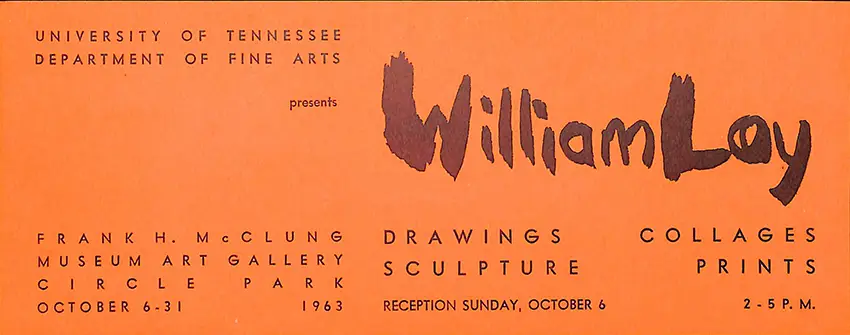
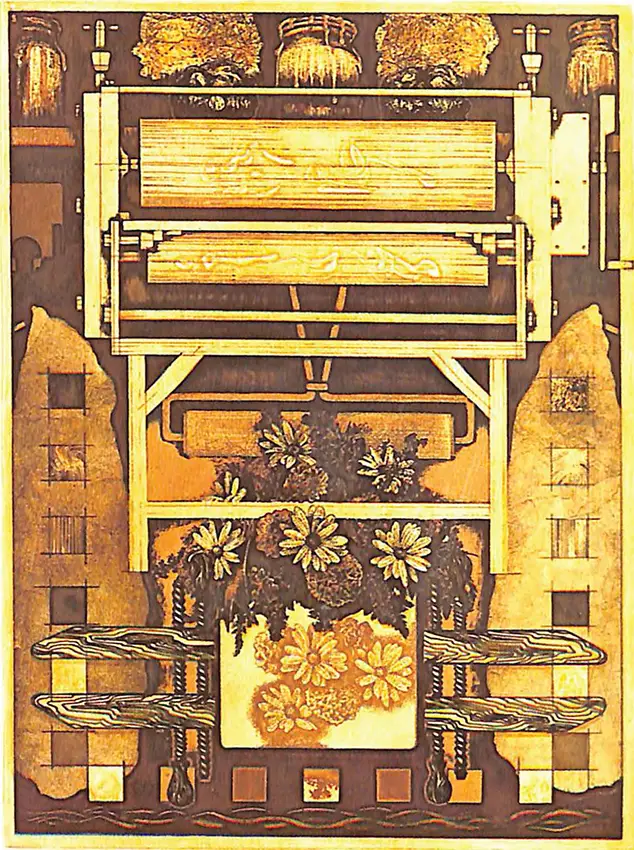
1960s
The foundation for the success of the UTK Printmaking Program was laid by Professor Byron McKeeby, (MFA, Tulane University, BFA School of the Art Institute of Chicago), a native of Iowa, whose grandfather was the model for Grant Wood’s painting “American Gothic.” While the Art Department also included William Loy (MFA, Wichita State University, BS, University of Wisconsin) who made prints, paintings, and sculpture, McKeeby was the first faculty member in the department with a full-time commitment to establishing the printmaking area.
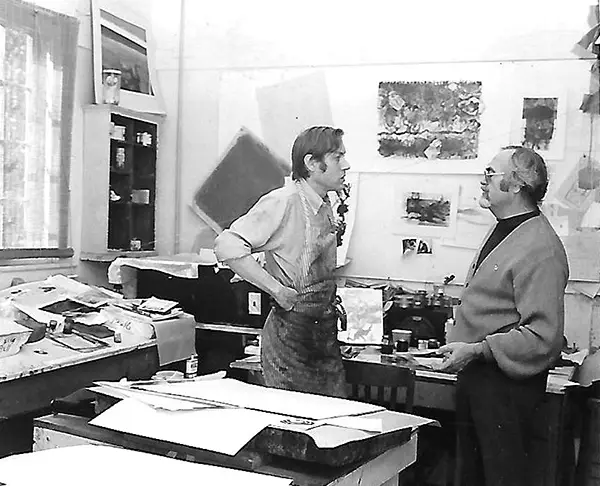
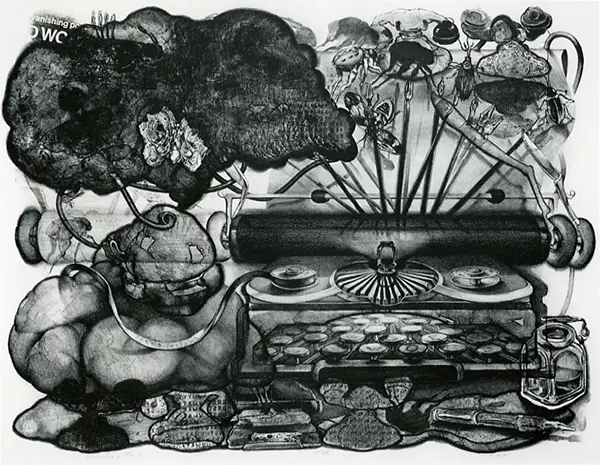
McKeeby was especially known for his black and white lithographs, having refined some of his methods through a summer fellowship at the Tamarind Institute. He was committed to the role of the print as a multiple, making works that reflected a strong humanist approach, exploring subjects as varied as baseball and literature, agriculture and the environment. He took advantage of the portability of print media, and was very active professionally, presenting his work in more than 200 group exhibitions and 19 one-person exhibitions during his two decades on the UTK faculty. He also presented a demonstration of his transfer methods at an early Southern Graphics Council conference.
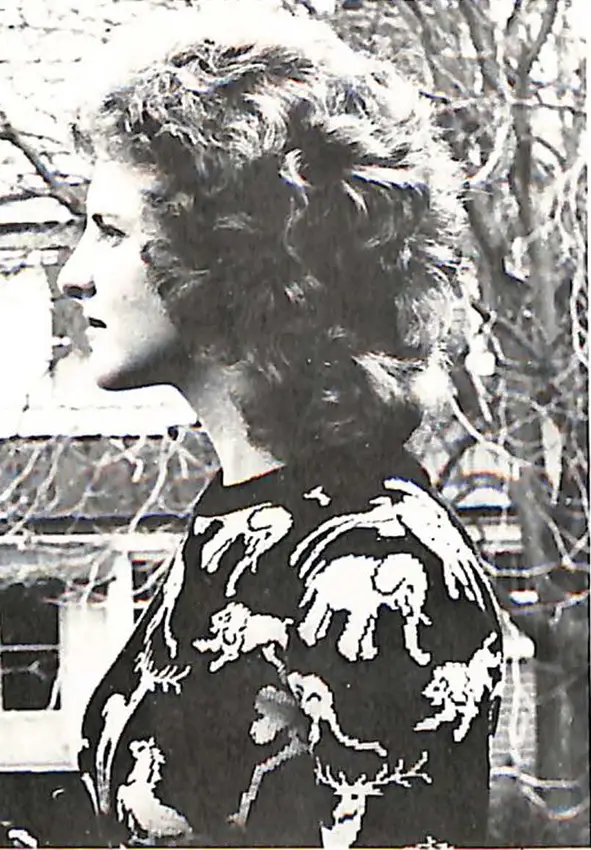
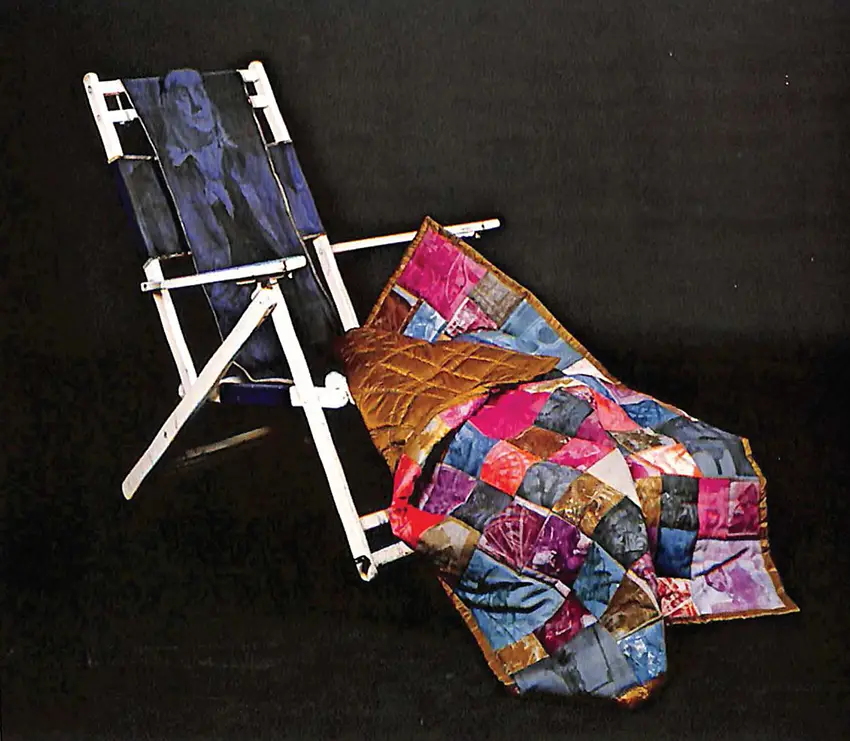

1970s & 1980s
In the period before the Department of Art moved with the College of Architecture in 1981 to its current building on Volunteer Blvd., the department was scattered among a number of homes formerly located along Melrose Drive where the International House now stands. The printmaking program occupied one of these houses, with presses and working tables arranged on the various floors. In the 1970s, the house was expanded to accommodate an additional press room. In 1972, Wendy Calman (MFA, Temple University, BA [Art History] University of Pittsburgh) was hired by Buck Ewing to a tenure-track position before she left UTK to accept a position at Indiana University in 1976. Calman taught some oil-based screenprinting, but mostly drawing, and pursued work that incorporated printmaking, drawing, and various photographic processes. In 1977, Brian Wells (MFA, Indiana University, BFA, Memphis State University) was hired. He had studied at Indiana with Wendy Calman, Rudy Pozzatti and Marvin Lowe. Wells brought color and plate lithography to the program, was involved in book arts, and taught a color and design course that was part of the art foundation program. Wells’ prints often combined abstract forms, sometimes made with unusual marking implements, and with imbedded text.
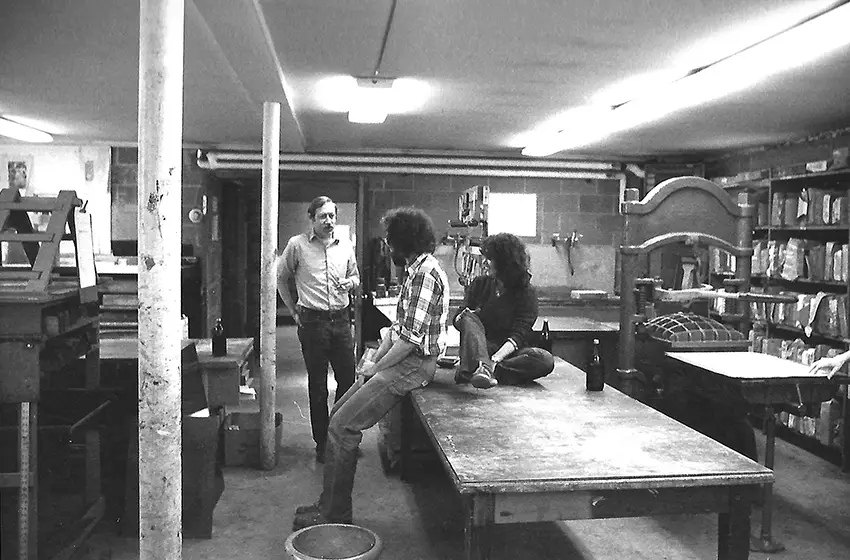
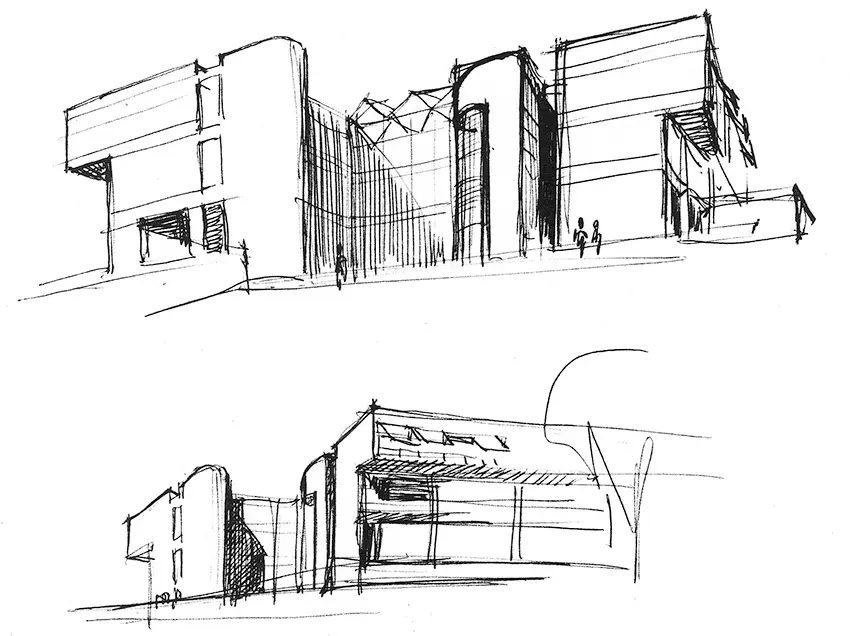
McKeeby was actively involved in the design of the printmaking studios for the new Art and Architecture Building. The building, designed by Knoxville architect Bruce McCarty included a large, integrated print studio encompassing intaglio, lithography, relief printing, and screenprinting. In addition, McKeeby, who was known for his combination of transfer methods and drawing, recognized the importance of photo-mechanical processes, and the program included a dedicated photo-print area and access to a process camera that was shared with the graphic design program. The department also had letterpress equipment that had been acquired by Bill Kennedy, who taught graphic design. This equipment, which included a Vandercook SP15 proofing press and a good collection of metal type, is the core equipment utilized by the UTK Letterpress Studio today.
In November 1984, only three years after occupying the print studios in the new building, McKeeby died of a heart attack at the age of 48. His diabetes was a contributing factor to his early death. Recognizing the need to protect the momentum of the program, the university quickly approved a national search for a tenure track faculty position, which lead to the hiring of Beauvais Lyons, (MFA from Arizona State University, BFA University of Wisconsin, Madison) who was a Visiting Assistant Professor at Weber State College in Ogden, Utah. In the fall of 1985, when Lyons joined the faculty, Brian Wells took a leave of absence to teach at his alma mater, Indiana University, eventually leaving his tenured position at UTK. Bill Loy had previously retired from the university.

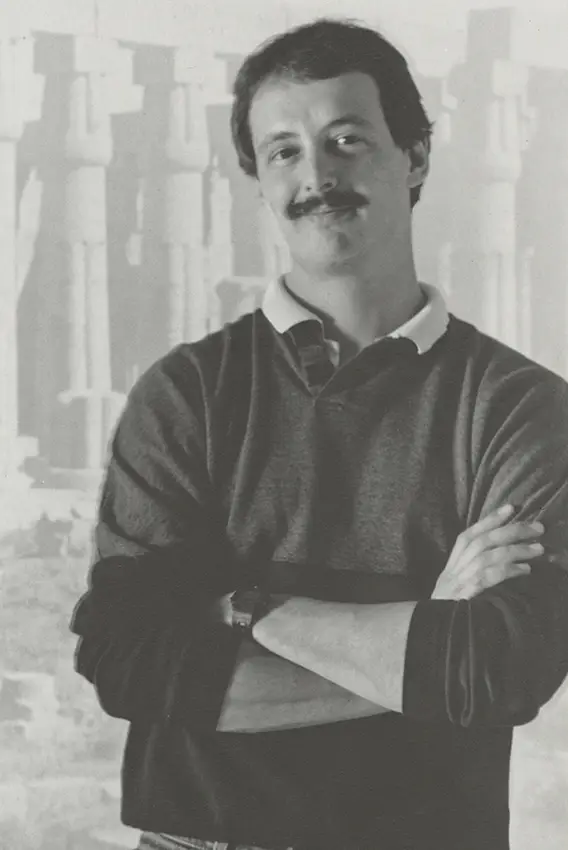
Building on the foundation established by McKeeby, Beauvais Lyons sought to reestablish the printmaking program. In 1986 and 1987, the program included artists-in-residence Andrew Rubin, then from Los Angeles where he had worked at Gemini Press, and Eleanor Rappe, from the City College of San Francisco. Following a national search in 1987, Pam Longobardi (MFA, Montana State University, BFA University of Georgia) was hired and together with Lyons, they attracted a new cadre of students, drawing graduate students to the program from both the United States and abroad. During this time Richard Daehnert, professor in the fibers program, taught screenprint, shifting from oil-based to water-based inks. Daehnert retired in the mid-1990s during a period of budget cutbacks and his position was not filled.
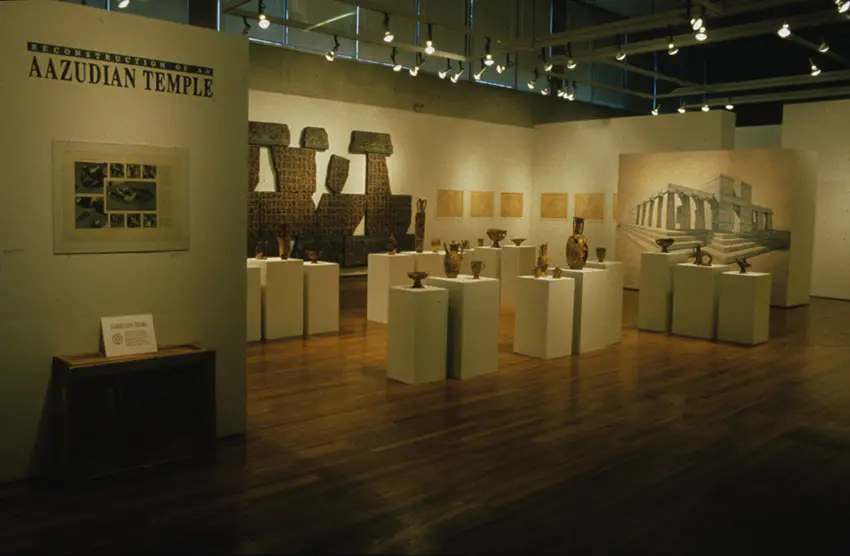
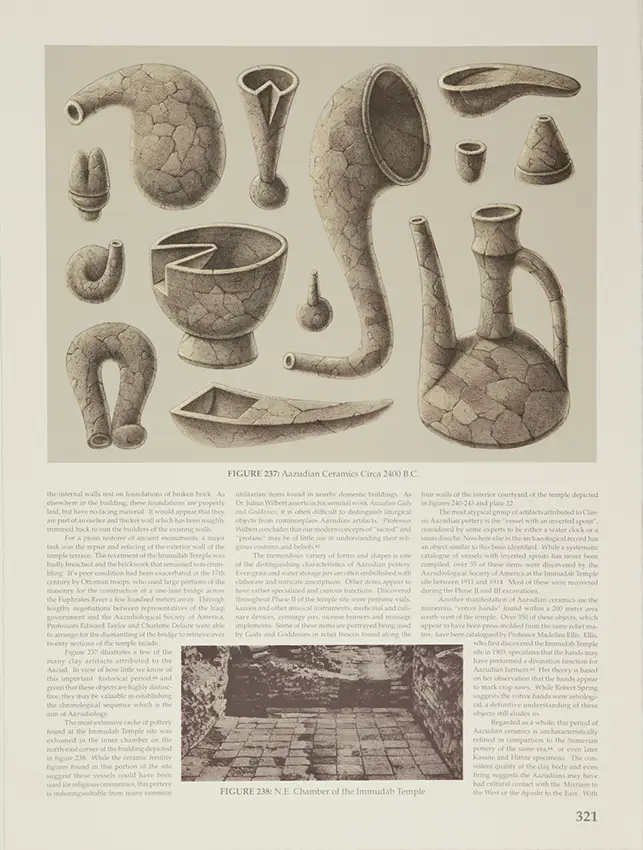

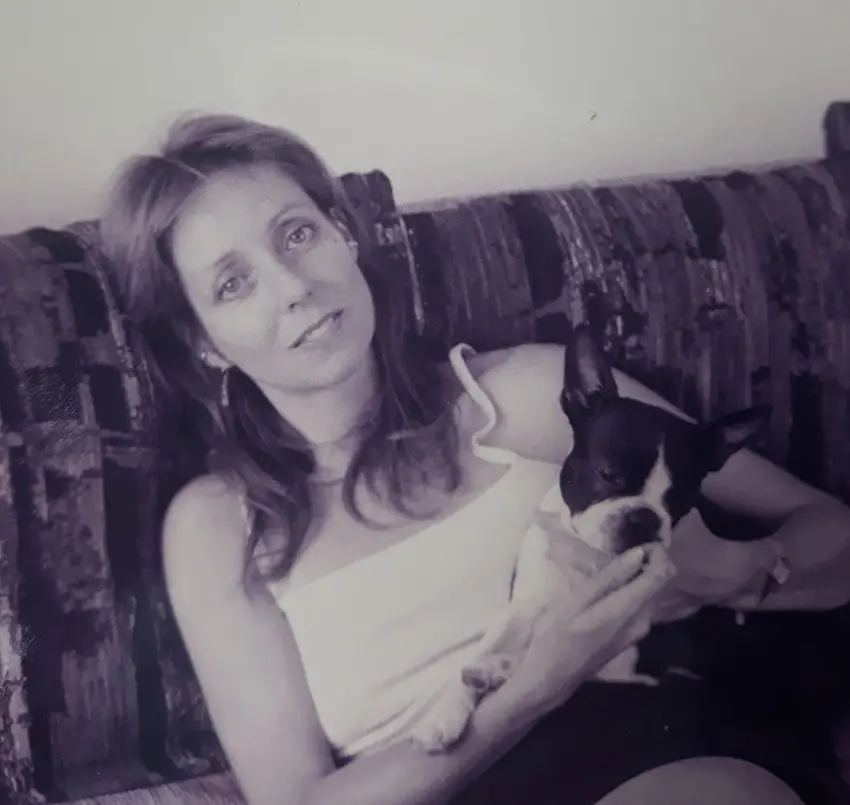
Longobardi and Lyons both sought to position printmaking as a media with its own material and social history, but one that was not isolated from arts and culture more broadly. As such, both were also engaged in other art media. For Lyons, this included ceramics and sculptural works as part of his mock-archaeological projects, which over the decades has involved other mock-documentary projects addressing subjects as varies as medicine, natural history, and a fictional circus. When she taught at UTK, Longobardi’s work not only pushed forms of printmaking, but she investigated painting (sometimes on the same copper plates she used for etching), photography, and other mixed-media methods. Envisioning printmaking in an expanded field of art practice served to both define and connect printmaking within a multi-disciplinary approach to art making. Both Lyons and Longobardi were exhibiting their work internationally, and were each recognized with individual artist fellowships from the Southern Arts Federation/National Endowment for the Arts.
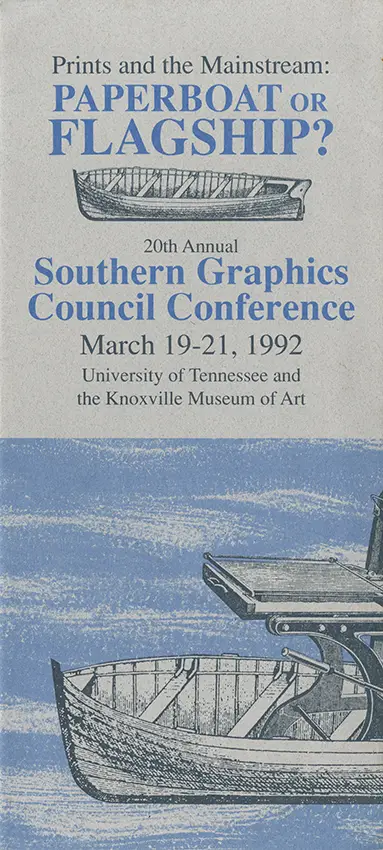
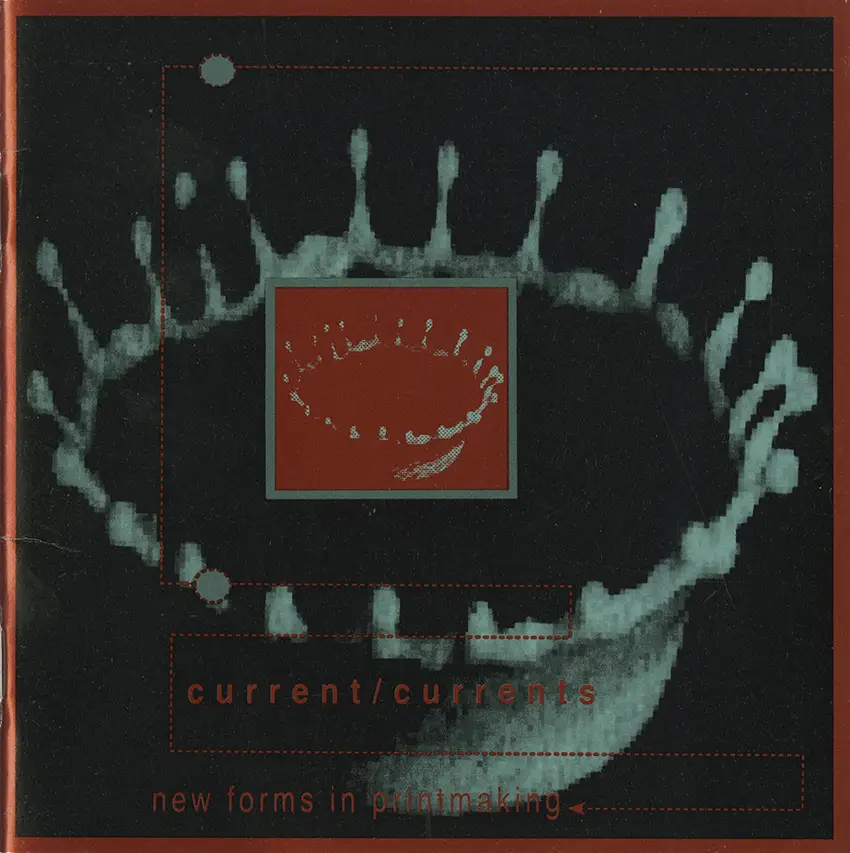
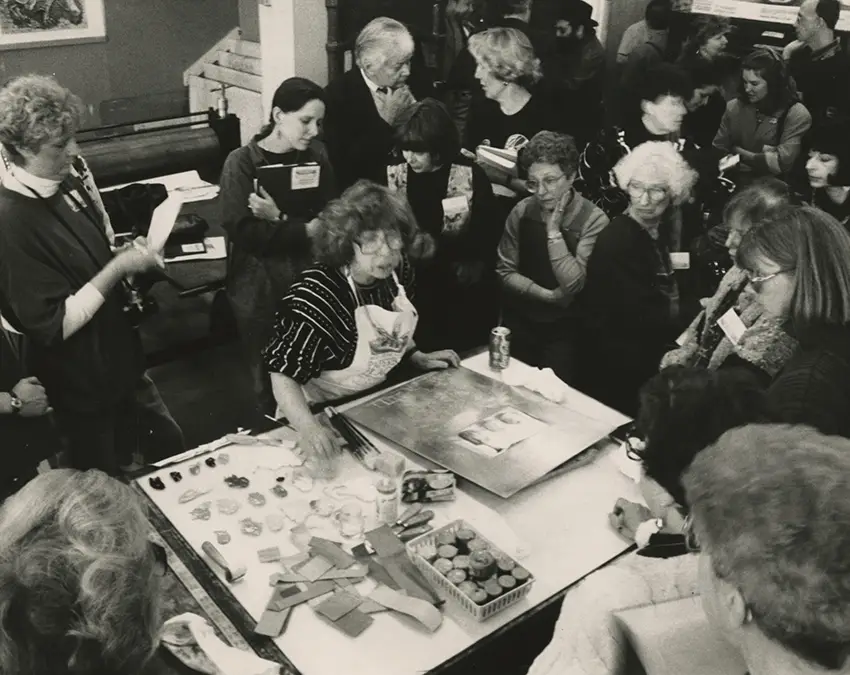
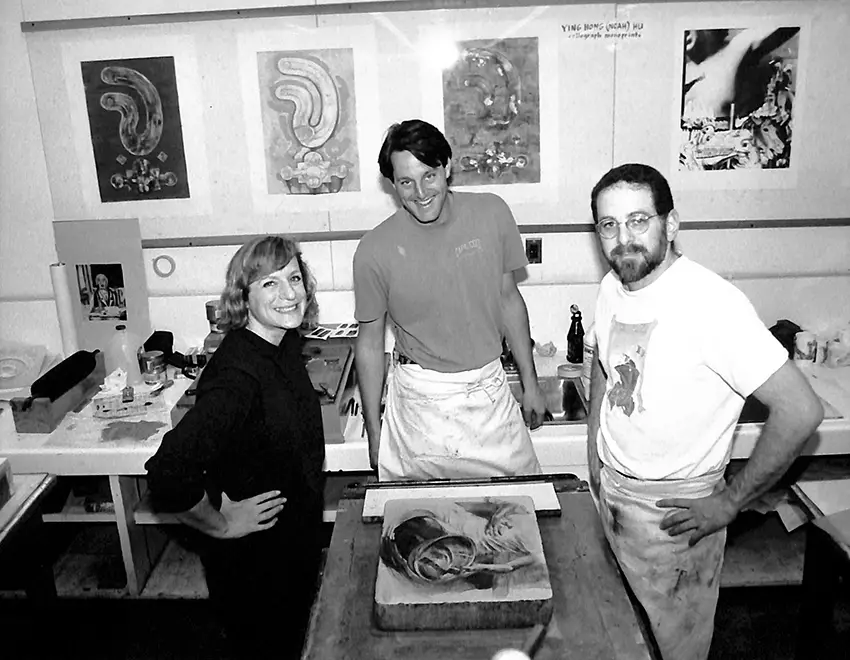
1990s
A significant event in the history of the program was hosting the Southern Graphics Council Conference in March of 1992. Held in cooperation with the newly constructed Knoxville Museum of Art, and using exhibition spaces in the nearby Candy Factory, the conference brought together more than 500 printmakers from the US and Canada. In conjunction with the conference, the program sponsored a retrospective exhibition of Byron McKeeby’s prints for which UTK Art History Professor Dale Cleaver conducted a gallery talk. The conference theme Prints and the Mainstream: Paperboat or Flagship addressed the role of the print in contemporary art, and included Current/Currents, an exhibition in the Ewing Gallery co-curated by Lyons and Longobardi surveying new forms of printmaking. Conference speakers included the print historian Beatrice Farwell (UC, Santa Barbara), James Cuno (Harvard University), Joan Moser (Smithsonian Museum of American Art), and Ruth Weisberg (University of Southern California).

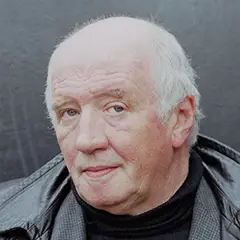

Connections between UTK and the Southern Graphics Council (now named SGC International) played a key role in advancing the reputation of the UTK Printmaking Program. Several UTK alumni served on the SGC International’s board, and Eun Lee (BFA ’00) served as president in 2010–12. Beauvais Lyons was elected to serve as SGC President from 1992–1994, served as the editor of their newsletter Graphic Impressions for four years, and UTK hosted their conferences again in 1995 and 2015. The 1995 conference, on the theme Beyond Labels included a keynote address by noted art critic Dave Hickey, 1993 author of Invisible Dragon: Four Essays on Beauty, as well as a presentation on “Using the Press” by the media prankster Joey Skaggs. June Wayne, founder of the Tamarind Institute received the 1995 SGC Printmaker Emerita Award and the Knoxville Museum of Art sponsored an exhibition of her lithographs. Attending the conference were faculty from the University of West England, who used the conference format as the basis for the IMPACT International printmaking conferences launched in Bristol in 1999 at which Beauvais Lyons was a key-note speaker. Lyons also was co-coordinator with John Risseeuw from Arizona State University for the 2002 SGC Conference Print Gumbo held in New Orleans for the organization’s thirtieth anniversary. Keynote speakers at the conference were the jazz legend Ellis Marsalis and the New Orleans artist John Scott.
In 1997, Longobardi, who grew up in Georgia, departed the University of Tennessee to teach painting at Georgia State University where she is currently a Regent’s Professor and Distinguished University Professor. Longobardi has established an international reputation for her ongoing Drifters Project addressing plastic waste in oceans. She returned to UTK in 2019 as a visiting artist and was part of Unsustainable, an environmentally themed exhibition in the Ewing Gallery. During the first year following her departure, Tim Dooley (MFA ’97), who is now on the faculty at the University of Northern Iowa taught in the program. During the following year, Chris Sperandio, now on the faculty at Rice University, taught in the program.


In 1999, following a national search, Anita Jung (MFA University of Wisconsin, BFA Arizona State University) and her husband Tom Christison (MFA Arizona State University, BFA University of Wisconsin-Eau Claire) joined the faculty, having both previously taught at Ohio University. Jung’s work investigated concepts of domesticity, feminism, and religion, often combining printmaking with painting and installation. Christison is known for his work with stone and plate lithography combined with monoprint methods. Christison’s work explored concepts of evolution, eminent domain, and the food chain. Before coming to Knoxville, Beauvais Lyons and Tom Christison organized the Drawn to Stone portfolio in conjunction with the 200th birthday of lithography in 1998, which is in the collections of the Smithsonian Museum of American Art and the Whitney Museum of American Art. During their time on the faculty, the program continued an active schedule of hosting visiting artists, including a student-led collaboration between UTK and University of Iowa graduate students. In 2006 Jung and Christison left UTK to help lead the printmaking program at the University of Iowa where Jung is currently a Professor of Art and Christison is a lecturer teaching printmaking. Iowa’s printmaking program has a long history of excellence and is also highly ranked.

2000s
In 2000, the printmaking program held an exchange exhibition with the Academy of Fine Arts in Poznań, Poland. As part of the project, each program gifted 50 prints by students and faculty to the other program as a cultural and teaching tool. The work from Poznań was exhibited in Knoxville and then shipped for short-term exhibitions to over 10 different universities, from the University of Nebraska to the Cleveland Institute of the Arts. Building on this exchange, Beauvais Lyons applied for and was awarded a Fulbright Fellowship to teach for one semester in the fall of 2002 in Poznań. During that semester he gave lectures on American printmaking at more than eight Polish art academies. In 2003, a linkage agreement was established, first with the Academy of Fine Arts in Poznań, and then the Eugeniusz Geppert Academy of Art and Design in Wrocław which allowed two students from Poland to come to Knoxville each September as guest artists and two students from Knoxville to be guest artists in Poland the following May. The exchange is a unique component of the UTK graduate program, and has added significant opportunities for participating students. Our Polish linkages have received support from the Marek Marie Pienkowski Foundation based in Knoxville.

As an outgrowth of his Fulbright, and with support from both UTK and a $10,000 grant from the Trust for Mutual Understanding, Lyons organized the IMPACT IV International Printmaking Conference in Berlin, Germany and Poznan, Poland in September 2005. The two-city conference lasted one week and was attended by more than 250 people from 28 countries. Among the attendees to the conference was Koichi Yamamoto, who would become a member of the UTK Printmaking faculty two years later.
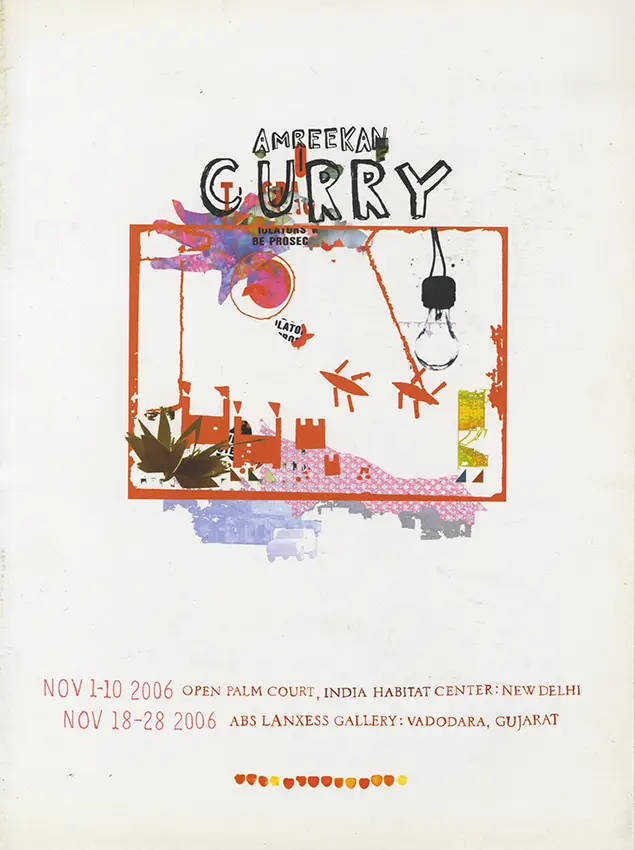
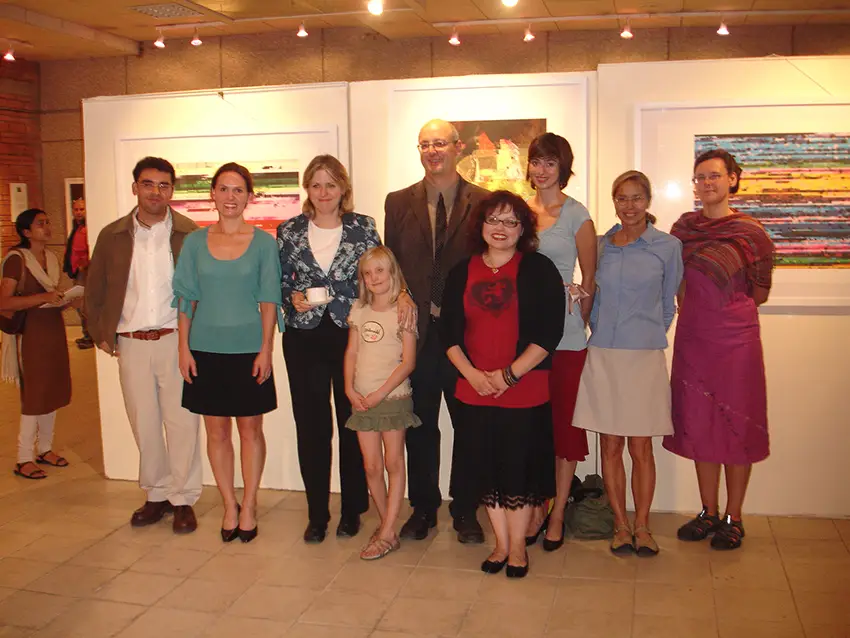
Another international project was Amreekan Curry, an exhibition of prints by students and faculty from the University of Tennessee organized by UTK graduate student Shaurya Kumar. Held in both New Delhi and Vadodara, India, in November 2006, a delegation including students, faculty, and one staff member traveled to India for 10 days as part of the project. The exhibition was supported through the UTK College of Arts and Sciences, the UTK Office of Research, and the Public Affairs Section of the American Center, New Delhi.

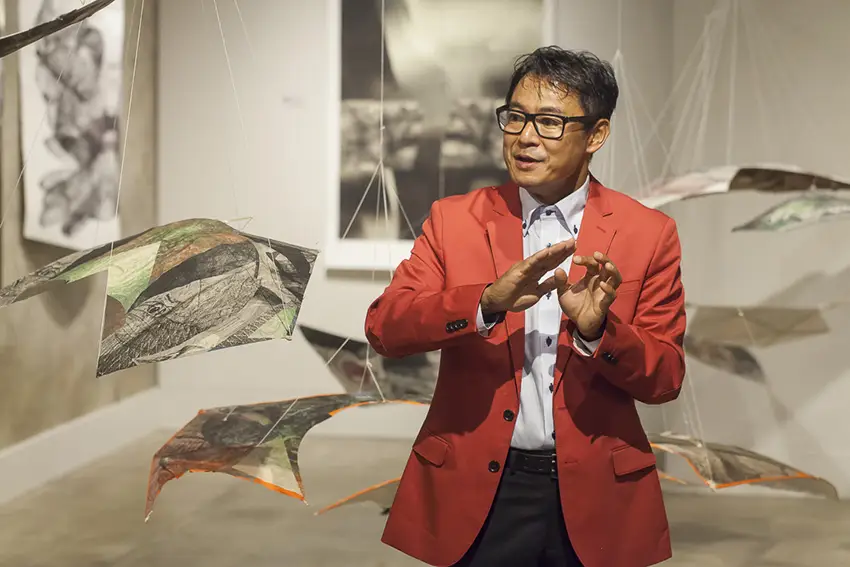
Following the departure of Jung and Christison, Cynthia Osborne, a recently retired professor from California State University, Long Beach, taught printmaking for one semester. Osborne was familiar with Knoxville, having attended both the 1992 and 1995 SGC conferences and had worked with Lyons to organize a California State University Summer Arts Workshop in 1998 in Long Beach. In 2007, through a national search, Koichi Yamamoto (MFA, University of Alberta, BFA, Pacific Northwest College of Art) was hired to join the program. Yamamoto brought an extensive record of creative work and teaching, having previously been tenured at Utah State University. With primary expertise in intaglio and relief printing, Yamamoto was also known for his large-scale monoprints, and more recent works that involved reflective transfer printing and printed kites. In 2021 he was the keynote speaker for the Print Austin annual symposium. Yamamoto also brought his own connections to Poland, having spent three years in Poland in the early 1990s, including at the art academy in Poznań where he studied before attending graduate school in Canada.


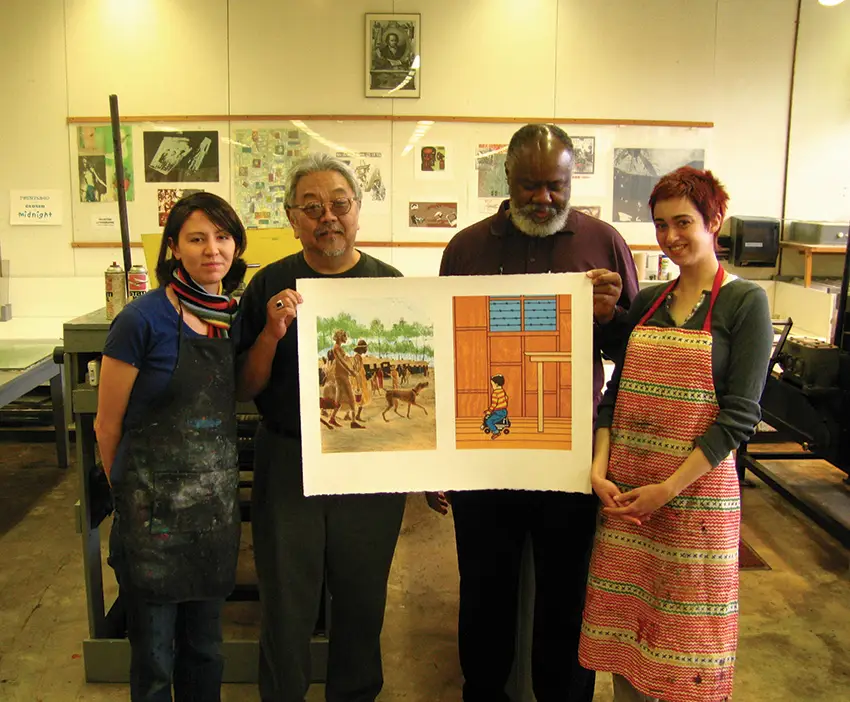





For more than three decades the program has hosted an active roster of visiting artists, critics, and curators, with many artists coming to the studio for a week to work on collaborative projects. Many of the visiting artists were funded through the Haines-Morris Endowment in the College of Arts and Sciences. Others were organized by the UT Print Club, a student organization that could apply for funds through the university. The roster of artists includes Sue Coe, Helen Frederick, Noel Anderson, Phyllis McGibbon, Yoonmi Nam, Sarah Suzuki, Susan Tallman, Katarina Burin, Ruth Marten, Karen Kunc, Andrew Raftery, Crystal Wagner, Aaron Coleman, Kathryn Polk, Yugi Hiratsuku, Tracy Templeton, Lothar Osterburg, Chakaia Booker, Kakyoung Lee, Michael Barnes, Kyle Schlesinger, and Steve A. Prince. The program also hosted the east Tennessee native and LA-based artist Wayne White to create a float for the annual homecoming parade. One of these projects involved the creation of two collaborative diptychs by Roger Shimomura and John Newman on the topic of the internment of Japanese-Americans during WWII. Prints published through these collaborations are in a number of important museum collections, including Eric Avery’s large-scale linocut with lithograph “Emerging Infectious Diseases” which is in the collection of the Museum of Modern Art.


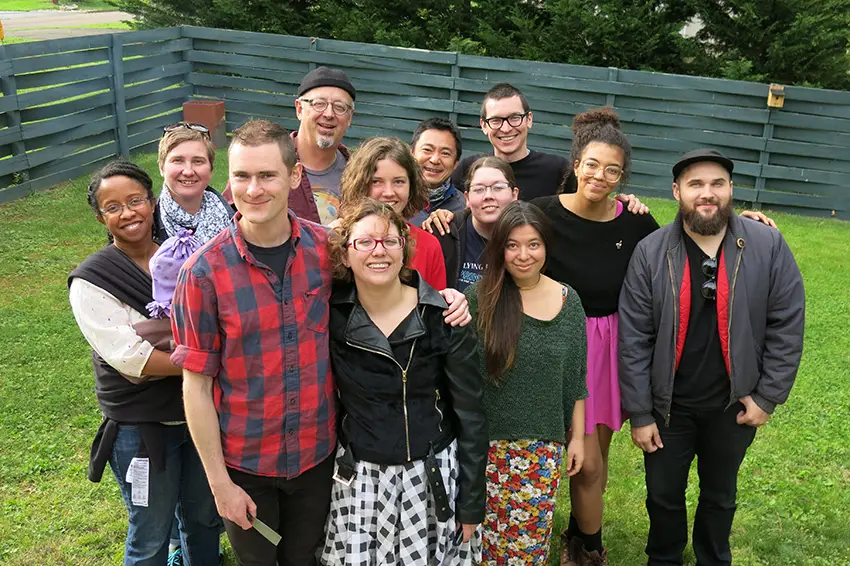
Over the years, several unique traditions have developed around the UTK Printmaking Graduate Program. One of these, begun when Koichi Yamamoto joined the faculty, is an annual tradition of making holiday photos which are sent via social media to colleagues in the US and abroad. The photos are varied, and have included a variety of themes. Since he joined the faculty we have also held an annual pontoon boat party on Norris Lake at the start of the academic year to foster community. Another tradition that was initiated was an annual ink knife ceremony for which MFA students receive an engraved ink knife to mark their graduation from the program. These traditions mark time and serve as a form of community building.

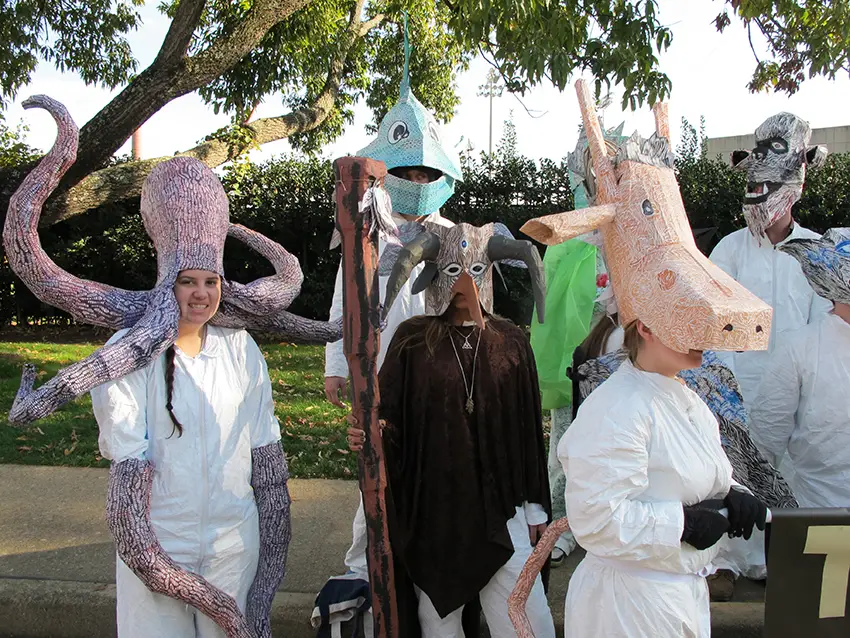

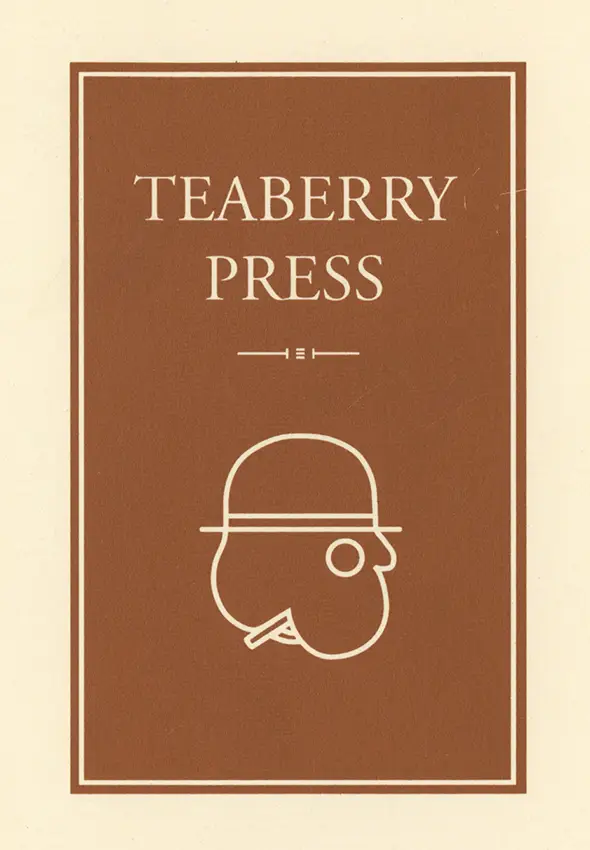
Even before the program moved into the new Art and Architecture Building, the McClung Museum art gallery hosted regular exhibitions of contemporary prints. One of these early shows Three Printmakers presented the work of Arthur Deshaies, Carol Summers, and Robert A. Nelson. Since then, the Ewing Gallery of Art and Architecture, under the direction of Sam Yates, has worked with printmaking faculty to present exhibitions of print media. The first invitational exhibition held in the new Ewing Gallery was Ten Printmakers, which was shown at East Tennessee State University following its initial presentation at the Ewing Gallery in 1983. The show included some key figures in American Printmaking including Patricia Bellan-Gillen (Carnegie Mellon University), Ray Gloeckler (University of Wisconsin), Ken Kerslake (University of Florida), Juergen Strunk (University of Dallas), and William Walmsley (Florida State University).
A year later, the Ewing Gallery presented an exhibition of printmakers and their students. Included in that show were a couple of students who would be future UTK faculty members, Pam Longobardi, then at Montana State University and Tom Christison, then at Arizona State University.
A good example of an exhibition project from the early 1990s was a national touring exhibition The Intimate Collaboration: Prints from the Teaberry Press featuring collaborative prints made by San Francisco-based artist and printer Tim Berry. Organized by Sam Yates, the exhibition travelled for more than a decade, included prints by Terry Allen, Squeak Carnwath, Christo, Jim Nutt, Claes Oldenburg, Ed Ruscha, and William Wiley. For the initial showing, Berry came to campus to work with faculty and staff in editioning a multi-plate color intaglio.
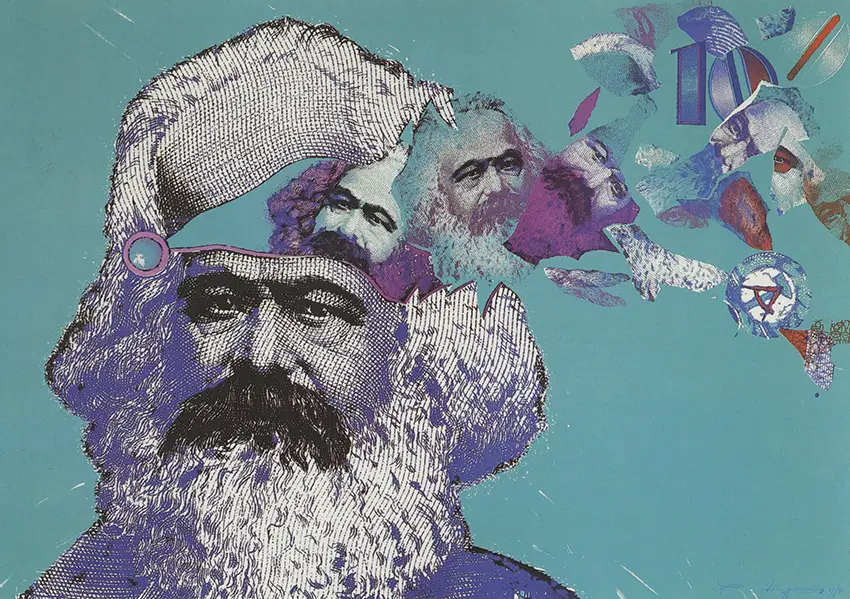


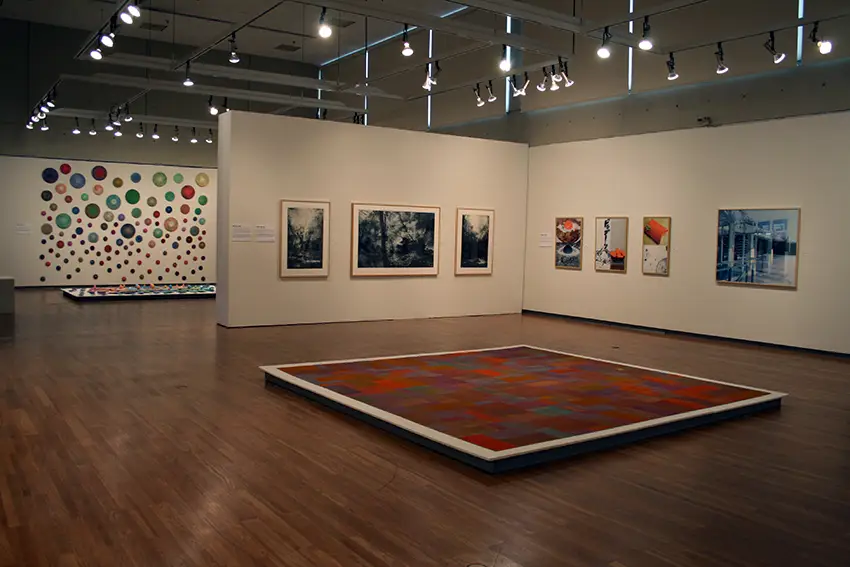
Other printmaking exhibitions presented in the Ewing Gallery have included The Big Print, an exhibition from 1993 of large-scale lithographs published through the Quensen Lithographic Studio in Lamspringe, Germany. The catalogue for the exhibition included a forward by Beauvais Lyons and an introduction by Leonard Lehrer who coordinated the exhibition. For the 1995 SGC International Conference, the gallery also presented Pace Prints, an exhibition from Pace Editions in New York. Another exhibition, Redefining the Multiple: 13 Japanese Printmakers, which was co-curated by Sam Yates and Hideki Kimura, Professor from Kyoto City University, traveled to 11 galleries and museums, from Wyoming and Wisconsin to Maine and Georgia following its initial showing in Knoxville in 2012. In preparation for the exhibition, Koichi Yamamoto accompanied Sam Yates on a trip to Japan. Through generous donor support, the exhibition catalogue was published for the 1,600 attendees as part of the 2015 SGCI conference, and Kimura was one of the featured speakers at the conference.

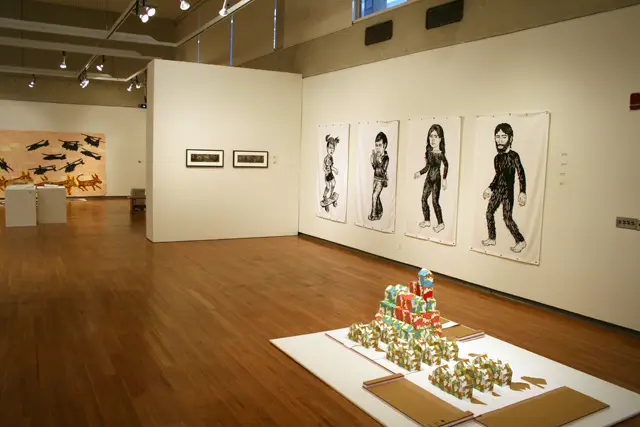
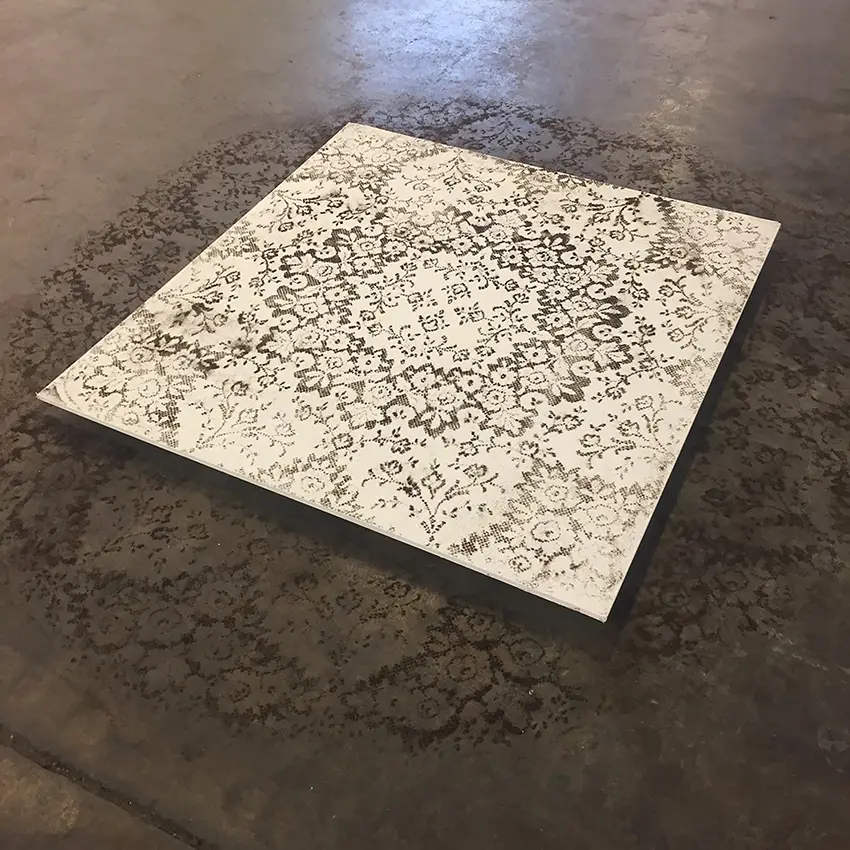
The Ewing Gallery also was the setting for Multiple x Multiple, an exhibition curated by Beauvais Lyons’ graduate students in 2009 that offered a survey of contemporary print media. The exhibition included Barry Moser’s “Pennyroyal Caxton” edition of the King James Bible with detailed wood engravings, collaborative prints from Tandem Press, and limited-edition screenprinted wallpaper designed by UTK printmaking alumnus Joshua Minnie (MFA ’04) with Flavor Paper. Included in this exhibition was the work of Althea Murphy-Price, who came to Knoxville as a visiting artist to install her large-scale hair stencil work “What Remains.”
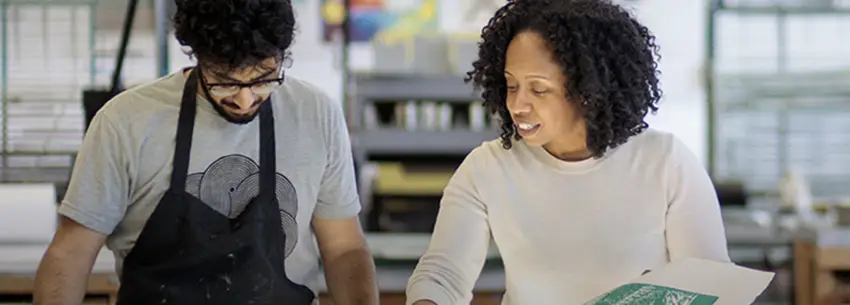

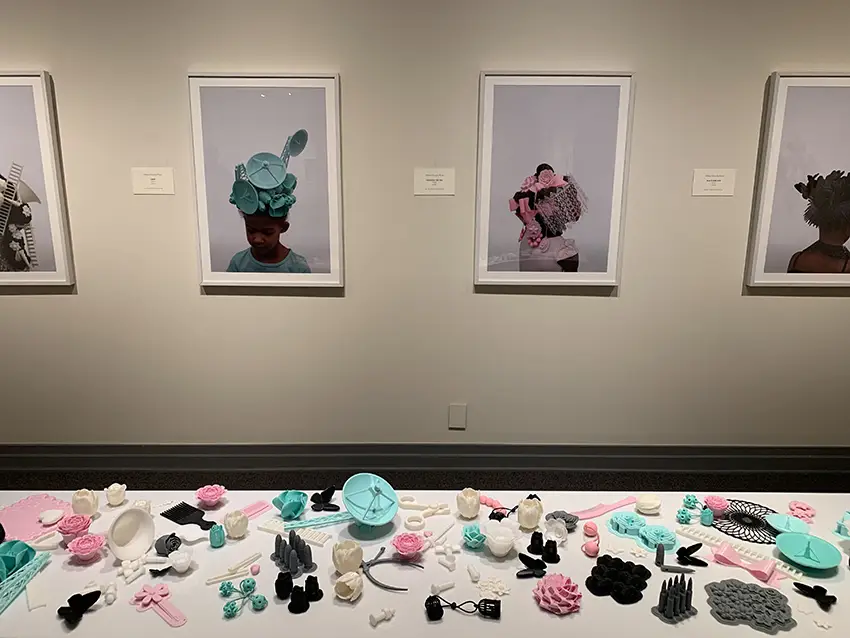
The following year, through support from the College of Arts and Sciences, the School of Art was able to recruit Althea Murphy-Price (MFA Temple University, MA Purdue University, BA Spelman College) to leave her tenure-track position at Indiana University to join the program as the third faculty member in printmaking. With a growing reputation for not only her lithographs and screenprints, but also sculptural and photographic works, Murphy-Price continues the program’s commitment to both honoring traditional aspects of the printed multiple while also extending its meaning and applications.


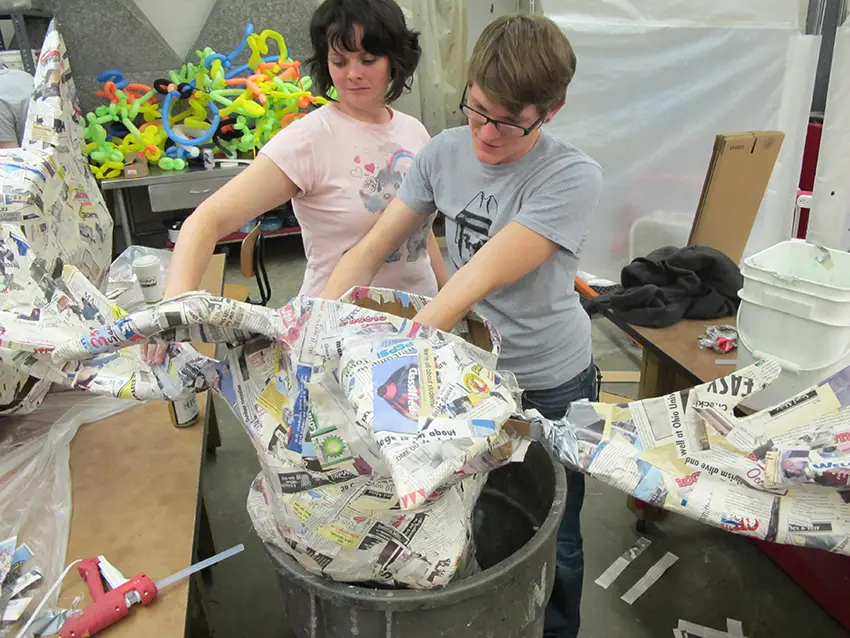
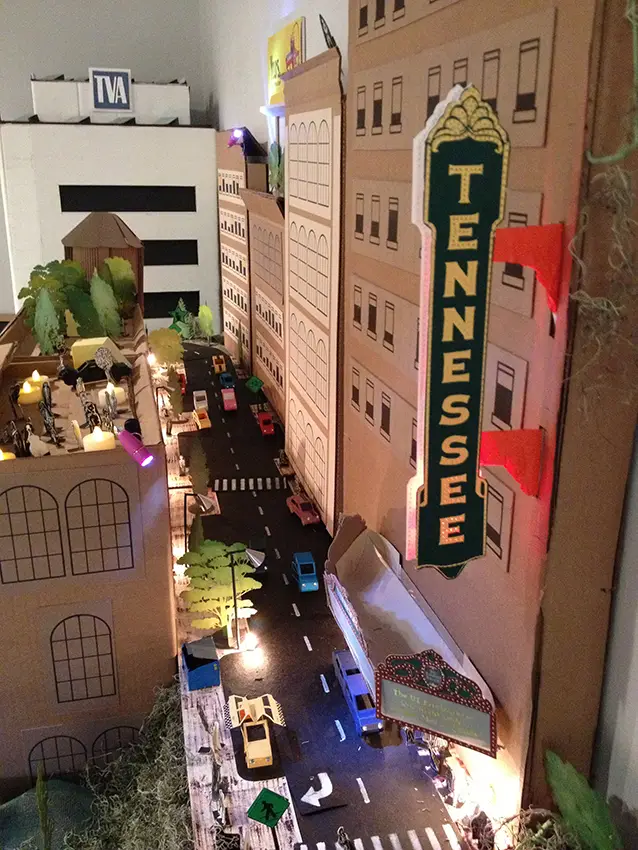
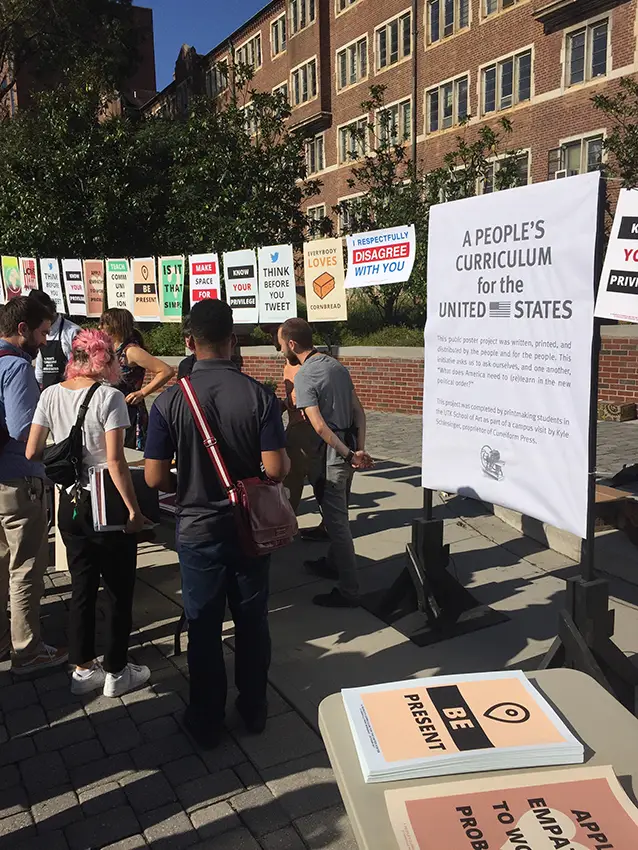
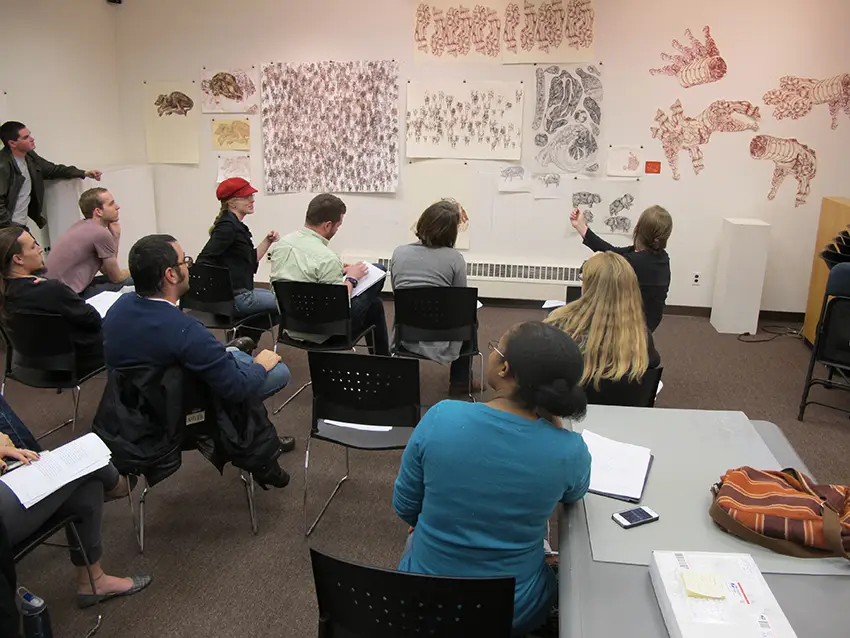
2010s
Since Althea Murphy-Price joined the faculty, the UTK printmaking program has remained engaged in not only the profession, but the local community. In January 2011, UTK faculty and graduate students collaborated with their peers from Ohio University in preparation for the annual Martin Luther King parade in Knoxville. For the project, a large-scale peace dove with printed feathers was created. Other prints and books were created and distributed as gifts along the parade route. The following year grads and faculty traveled to Athens, Ohio, for a project involving printmaking and balloon art in conjunction with their annual Halloween Block Party. These collaborations fostered subsequent activity with colleagues from both Ohio University and Northern Illinois University creating “The Bridges Project,” a 1:50 scale printed representation of Knoxville for exhibition at the 2013 SGCI Conference in Milwaukee, Wisconsin. Community engaged printmaking also informed a visit by Austin, Texas, poet and printer Kyle Schlesinger who worked in collaboration with UTK students in the creation of 11 different screenprints as part of his People’s Curriculum for the United States. The posters, with messages such as “Be Present” and “Think Before You Tweet” were distributed for free to encourage dialogue about diversity and inclusion.

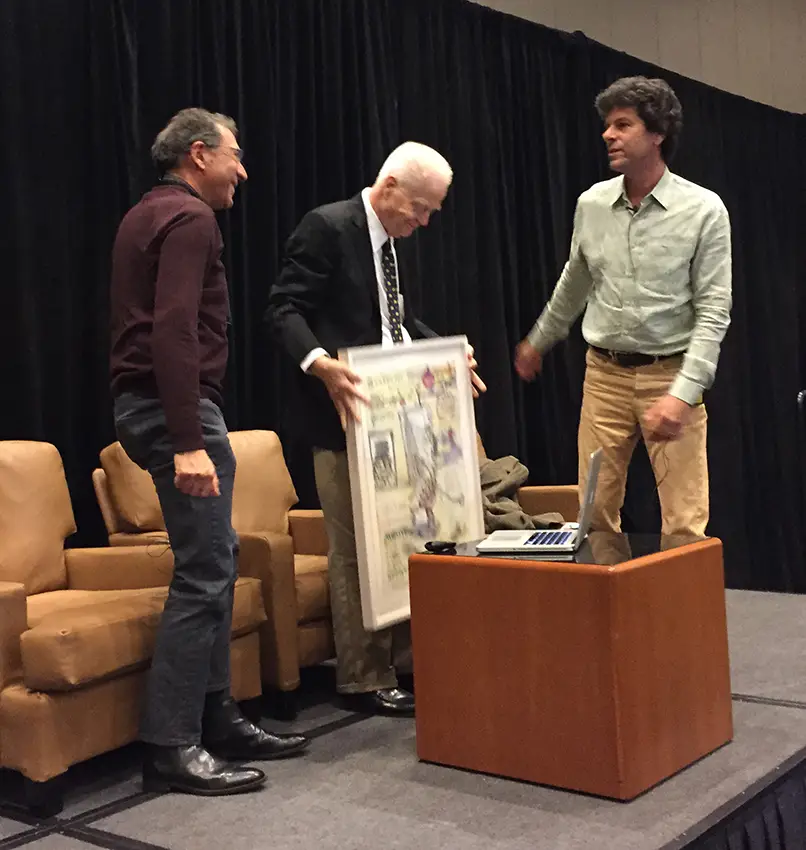
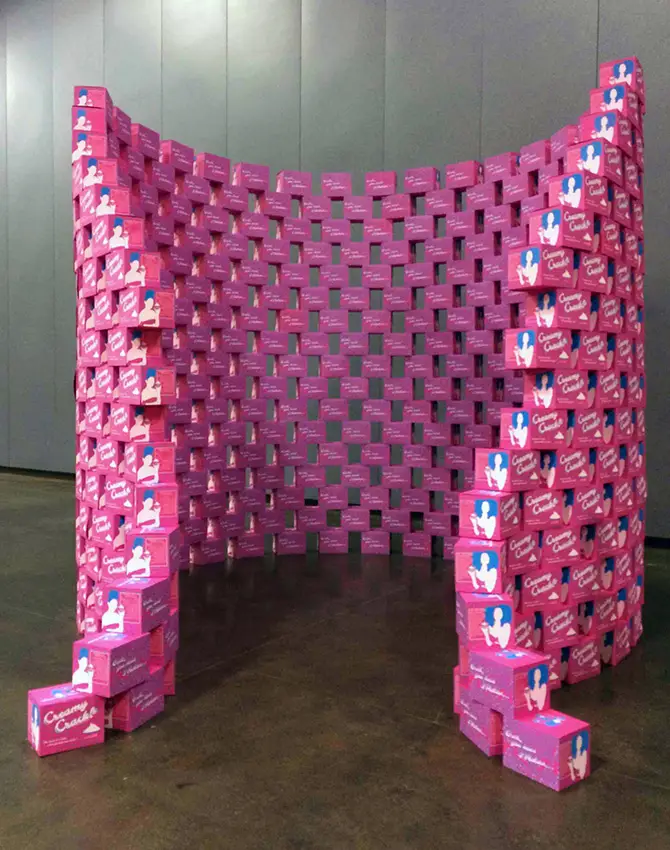
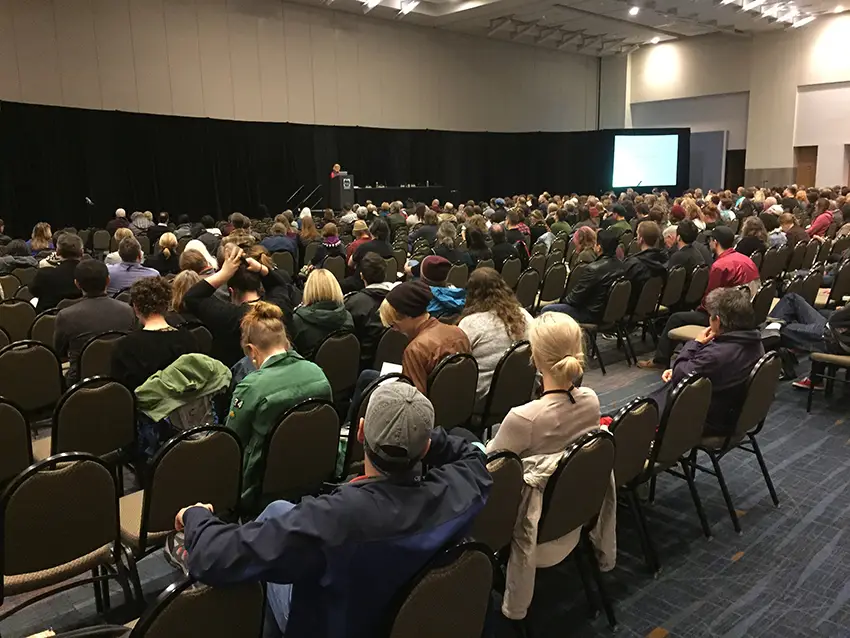
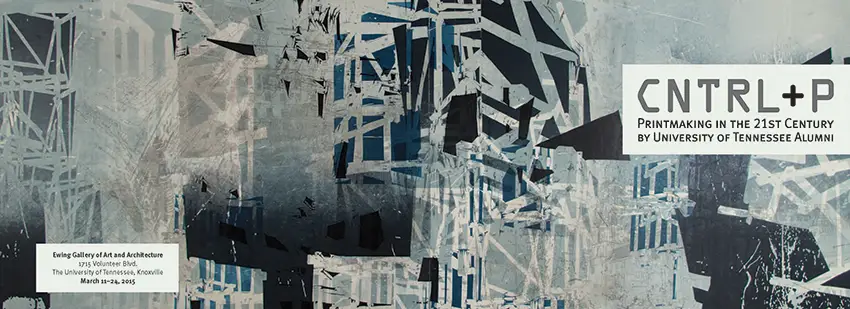
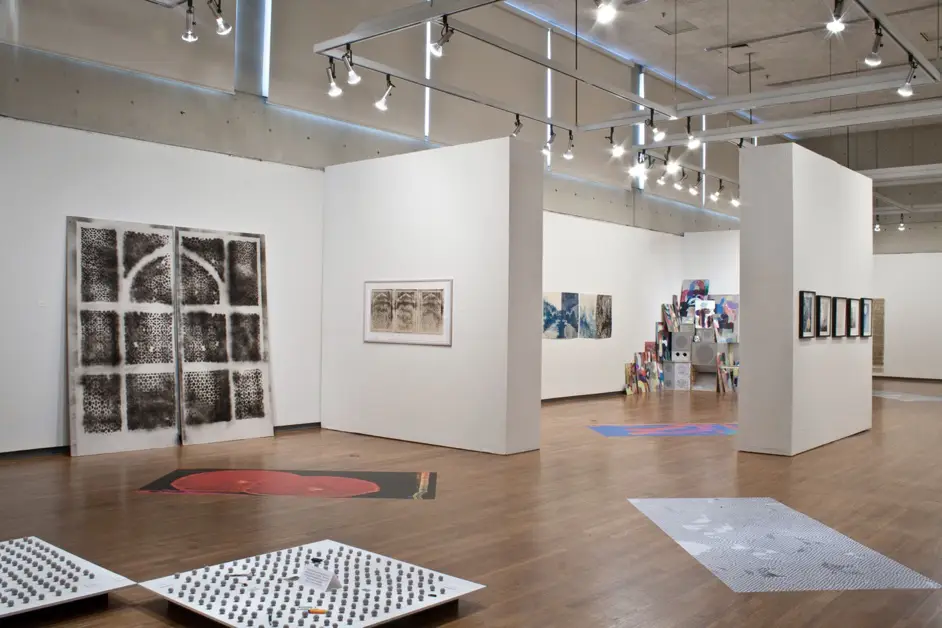
In March 2015, UTK hosted the SGC International Conference for the third time. On the theme of Sphere, the conference took place at the Knoxville Convention Center and locations on and off campus. Sphere was attended by over 1,600 delegates from 12 countries and 49 states. The conference honored Ruth Weisberg as Printmaker Emerita and included her one-person exhibition, Time and Again, at the UT Downtown Gallery. Sphere showcased numerous exhibitions, including Drawn from the McClung Museum, an exhibition and portfolio of 28 prints organized by Sydney Cross interpreting works in the collection of UT’s McClung Museum of Natural History and Culture; Lift: Contemporary Printmaking in the Third Dimension. curated by Stephen Wicks at the Knoxville Museum of Art; and CNTRL+P, a show curated by Sarah Suzuki from the Museum of Modern Art in New York featuring the work of UTK Printmaking Alumni. As part of the conference, UTK graduate student Raluca Iancu (MFA ’02) organized Prints in Peculiar Places, a series of “printstallations” along the Jackson Ave. in downtown Knoxville.

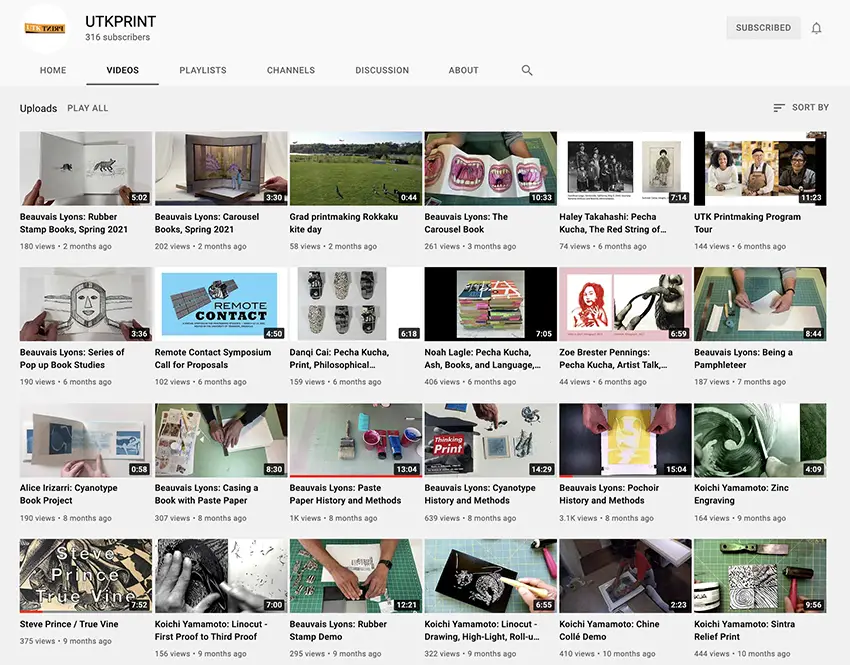
The commitment to be professionally active is one that UTK printmaking graduate students share. Taking place in 2021 during the COVID-19 global pandemic, the students organized and hosted Remote Contact, a two-day virtual printmaking symposium featuring current and recent student presenters from Australia, South Africa, the United Kingdom, Canada, and the United States. UTK Art History faculty Kelli Wood and Sean Roberts gave a plenary talk on the impact of playing cards on the development of printmaking in Europe, a second plenary talk was given by Umberto Giovannini from Italy, and the keynote address was by Miranda Metcalf from the popular printmaking podcast Pine/Copper/Lime.
Another initiative that grew out of the COVID-19 pandemic was the creation of the UTKPRINT YouTube Channel, which provides a platform to present lectures and technical demonstrations by UTK faculty and students. Graduates from the UTK remain active as artists, designers, and educators, exhibiting their work both in the United States and abroad and holding faculty positions at Vanderbilt University, Iowa State University, Purdue University, the School of the Art Institute of Chicago, and Nova Scotia College of Art and Design University, among others. To learn more about UTK printmaking graduates, see the UTK Printmaking Alumni webpage and our recent annual newsletters.
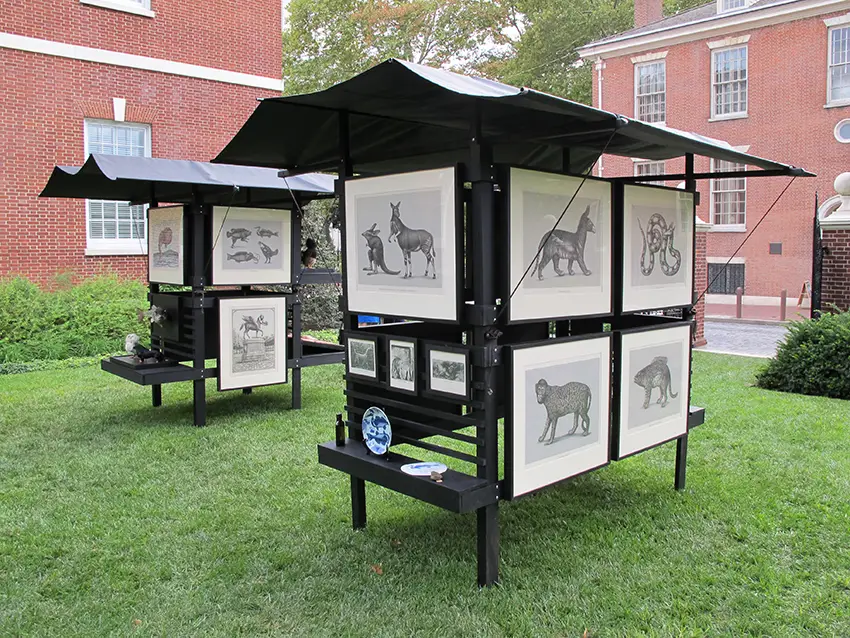
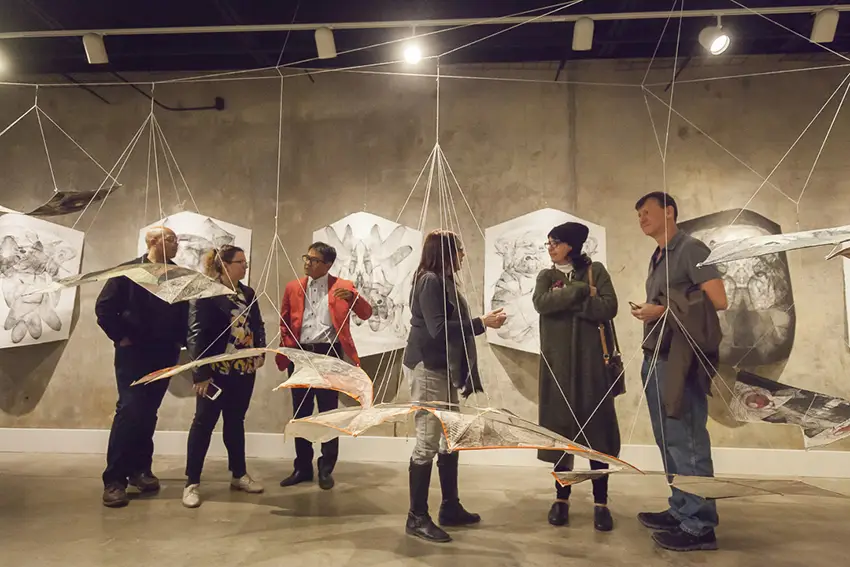
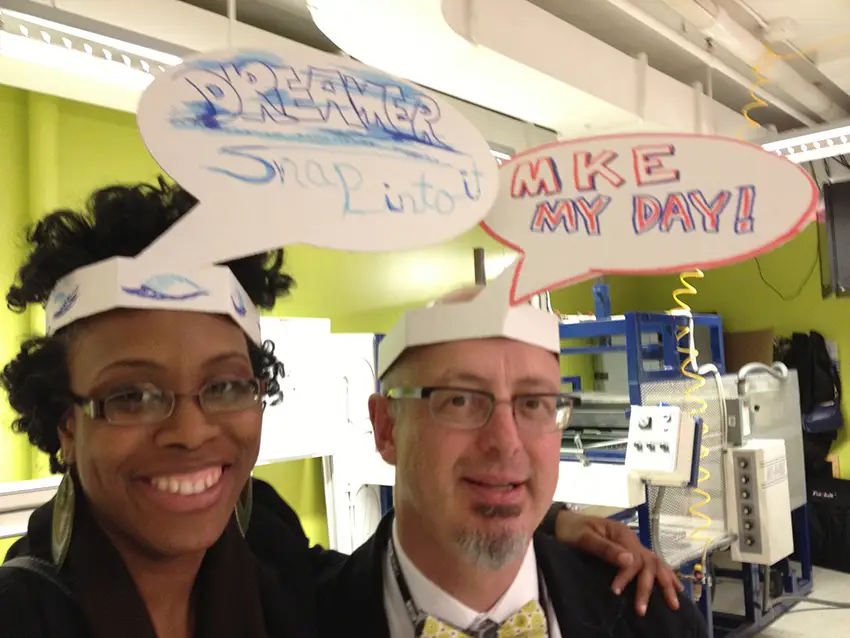
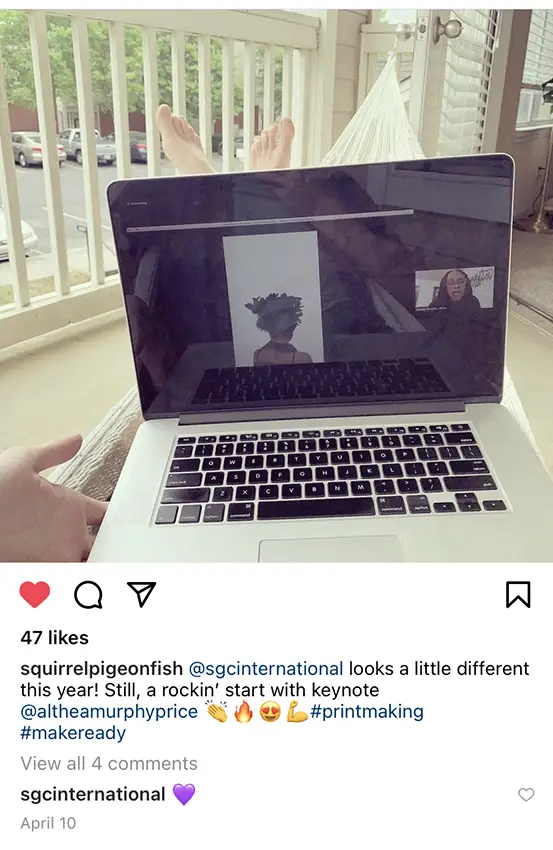
The UTK Printmaking Program has been enriched not only through the talent and energy of the faculty and students, but donors and friends of the program. This includes the Betsy Worden Printmaking Fund, which was established in 2006 in honor of Knoxville painter, printmaker, and weaver, Betsy Worden. The fund has played a vital role in helping to support our Polish exchanges and programming for the Printmaking Showcase Gallery. In 2008, the large American French Tool Intaglio Press in the UTK Printshop was named in honor of Betsy Worden. The program has also benefited from the generosity of Rick and Marilyn Turner, who recently established an endowment in support of the printmaking program. Both of these endowments will provide recurring funds to ensure that printmaking at the University of Tennessee, Knoxville, will remain strong and relevant in the future.
2020s
In July 2023, Beauvais Lyons began as the Divisional Dean for Arts and Humanities in the UT College of Arts and Sciences. He continues to be involved in mentoring graduate students.
In the Fall of 2024 J. Leigh Garcia joined the printmaking program as an Associate Professor of Art, having taught previously at Kent State University. Garcia received her MFA and MA from the University of Wisconsin-Madison and BFA from the University of North Texas.

This narrative was compiled by Beauvais Lyons, with input from Althea Murphy-Price, Koichi Yamamoto, Nancy Laemlein, Sam Yates, Sarah McFalls, Marcia Goldenstein, Tom Riesing, Pam Longobardi, Anita Jung, Don Kurka, Tim Massey, and Wendy Calman. Comments and revisions should be emailed to Beauvais Lyons.